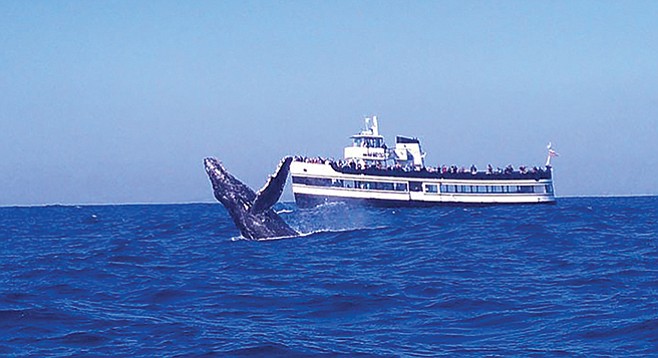 Facebook
Facebook
 X
X
 Instagram
Instagram
 TikTok
TikTok
 Youtube
Youtube

Once known as Devilfish by whalers due to their defending themselves and their young when attacked, the Eastern Pacific gray whales are migrating again off the San Diego coast.
In the Arctic feeding grounds, where they do most of their bulking up for the year, some 95 percent of their diet consists of very small shrimp and crustaceans.
When feeding on the bottom, the gray whale will take a deep breath, arch its body, throw its flukes high into the air, and dive deep. Once on the bottom, it will roll onto its side and “shovel” its head along the bottom, scooping up the top quarter-foot or so of life-filled mud and leaving a trench in the ocean floor. Then, by expanding and contracting its throat grooves and withdrawing its huge tongue, the whale sucks up the sediment as a person might a lumpy milkshake. As it rises from the bottom, the whale then pushes the mud through the baleen, which acts like a filter retaining only the amphipods, mollusks, tube worms, and other bottom invertebrates.
Once thought of as bottom-feeders only, which didn’t feed while migrating, gray whales have been recently observed foraging in kelp beds for shrimps and gulping up swarms of pelagic crabs and krill. The pelagic crab in the southern California waters might add a bit of excitement to the season, which runs late-December through early April.
Flag Ship Cruises and Event’s whale-watch boat, the Marietta, is running daily tours in conjunction with the Birch Aquarium at Scripps. When: December 19–April 17, 9:30 a.m.–1:15 p.m. and 1:30–5 p.m. daily.


Once known as Devilfish by whalers due to their defending themselves and their young when attacked, the Eastern Pacific gray whales are migrating again off the San Diego coast.
In the Arctic feeding grounds, where they do most of their bulking up for the year, some 95 percent of their diet consists of very small shrimp and crustaceans.
When feeding on the bottom, the gray whale will take a deep breath, arch its body, throw its flukes high into the air, and dive deep. Once on the bottom, it will roll onto its side and “shovel” its head along the bottom, scooping up the top quarter-foot or so of life-filled mud and leaving a trench in the ocean floor. Then, by expanding and contracting its throat grooves and withdrawing its huge tongue, the whale sucks up the sediment as a person might a lumpy milkshake. As it rises from the bottom, the whale then pushes the mud through the baleen, which acts like a filter retaining only the amphipods, mollusks, tube worms, and other bottom invertebrates.
Once thought of as bottom-feeders only, which didn’t feed while migrating, gray whales have been recently observed foraging in kelp beds for shrimps and gulping up swarms of pelagic crabs and krill. The pelagic crab in the southern California waters might add a bit of excitement to the season, which runs late-December through early April.
Flag Ship Cruises and Event’s whale-watch boat, the Marietta, is running daily tours in conjunction with the Birch Aquarium at Scripps. When: December 19–April 17, 9:30 a.m.–1:15 p.m. and 1:30–5 p.m. daily.
Comments